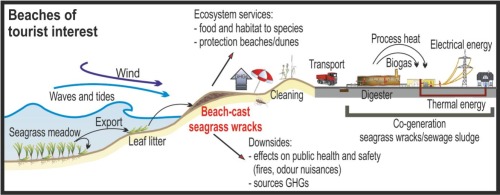Journal of Cleaner Production ( IF 9.7 ) Pub Date : 2020-01-13 , DOI: 10.1016/j.jclepro.2020.120131 Gloria Misson , Matia Mainardis , Guido Incerti , Daniele Goi , Alessandro Peressotti

|
Seagrass meadows are important productive ecosystems; during the Summer period in touristic beaches, such as those located in the high Adriatic coast, seagrasses are removed from the shoreline and disposed in landfill. This study investigated anaerobic digestion potential of beach-cast seagrass wrack, considering the physicochemical characteristics of the substrate and analysing heavy metal presence in the digestate, with the aim of transporting the material to local wastewater treatment plants to increase biogas yield from excess sludge anaerobic digestion. The methane production obtained from seagrass wrack was compared with three theoretical models. Seagrass wrack had a good methane potential of 103.1-262.3 NmL CH4/g Volatile Solids (VS), depending on substrate humidity and applied inoculum-to-substrate ratio. Predictive models, based on elemental composition and proximate analysis, successfully estimated methane yields; heavy metal concentration in digestate was low, boosting for digestate agricultural reuse. A simplified energy analysis revealed that transport to local wastewater treatment plants and use in anaerobic digestion process would provide up to 245,000 Nm3/y of methane, with an estimated economic income of 33,500-193,300 €/y, considering local seagrass production (1,465-8,454 t/y). Actual yearly costs sustained by beach management company for landfill disposal was about 117,200-676,320 €/y. Seagrass reuse in local digesters would compensate for the lack of excess sludge encountered during the cold season, allowing the digester to operate more continuously, increasing biogas production and reducing plant energy need.
中文翻译:

滩涂海草残骸厌氧消化潜在甲烷产量的初步评估:以高亚得里亚海海岸为例
海草草甸是重要的生产生态系统。在夏季,在旅游海滩上(例如位于亚得里亚海沿岸的那些海滩),海草从海岸线上移走并填埋。这项研究考虑了基质的理化特性并分析了消化液中重金属的存在,研究了滩涂海草残骸的厌氧消化潜能,目的是将材料运输到当地的废水处理厂,以提高剩余污泥厌氧消化的沼气产量。 。从海草残骸获得的甲烷产量与三种理论模型进行了比较。海草残骸的甲烷潜力很高,为103.1-262.3 NmL CH 4/ g挥发性固体(VS),取决于底物湿度和所施加的接种物与底物比率。基于元素组成和最近分析的预测模型成功估算了甲烷产量;消化液中的重金属浓度低,促进了消化液的农业再利用。简化的能源分析表明,运往当地废水处理厂并用于厌氧消化过程将提供高达245,000 Nm 3每年的甲烷排放量,考虑当地海草产量(1,465-8,454吨/年),估计经济收入为33,500-193,300欧元/年。海滩管理公司维持的每年实际实际费用约为117,200-676,320欧元/年。海草在当地沼气池中的再利用将弥补寒冷季节遇到的过量污泥的缺乏,使沼气池能够更连续地运行,从而增加沼气产量并减少植物能源需求。











































 京公网安备 11010802027423号
京公网安备 11010802027423号